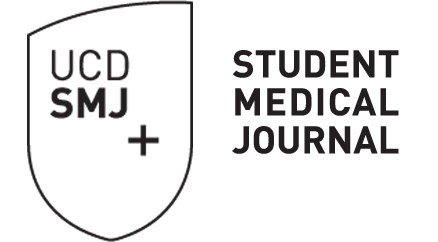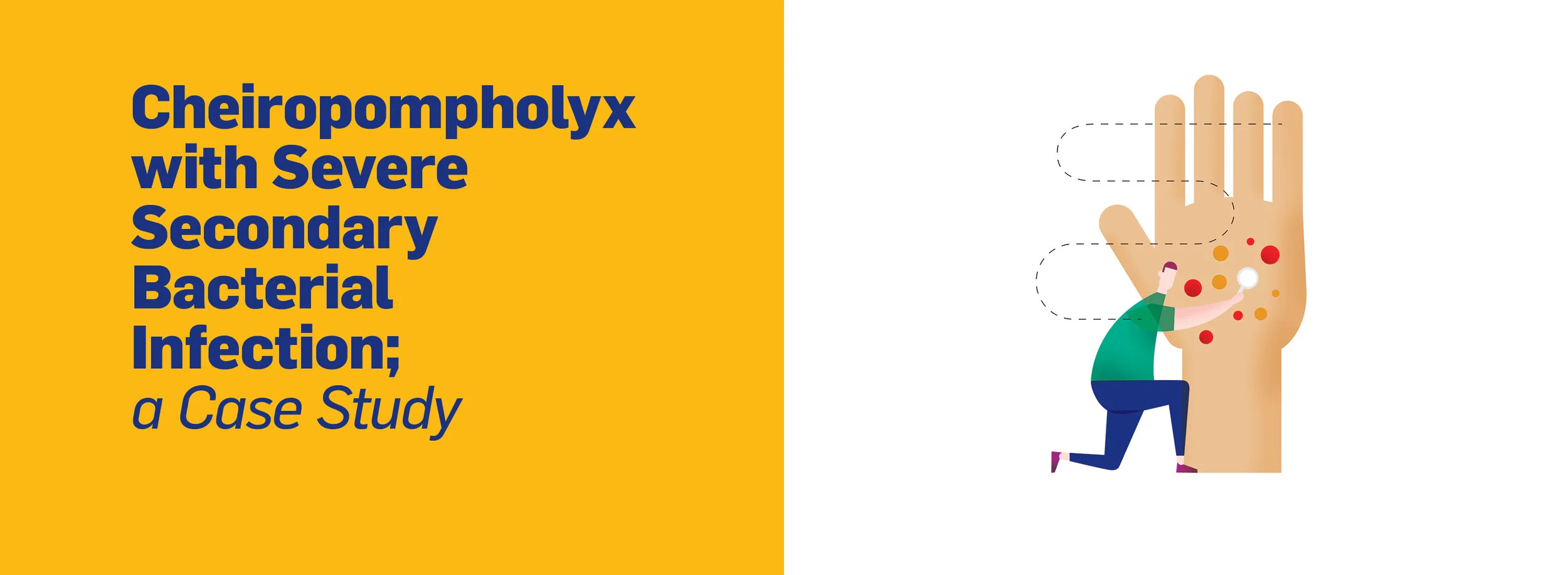Cheiropompholyx with Severe Secondary Bacterial Infection; a Case Study
Amal Hubail, Belkharoeva R, Valentina O, Tepljuk N
ABSTRACT
AIMS
The aim is to evaluate the clinical features of cheiropompholyx with severe secondary bacterial infection.
METHODS
A case of cheiropompholyx diagnosed in the patient with previous eczema complicated with a severe bacterial secondary infection.
CONCLUSIONS
Pompholyx is a non-fatal condition, but it can affect the quality of life if not treated properly. Established treatments are limited in literature and more research is needed.
Article
INTRODUCTION
Pompholyx (also known as Dyshidrotic eczema; DE) is an inflammatory skin disease with two subclasses: cheiropompholyx, where DE affects the hands and podopompholyx, where DE affects the feet1. DE is characterised by the sudden onset of vesicles, blisters, and bullae on the palms and soles. With disease progression, vesicles can expand and fuse, eventually causing deep fissuring2. Deep blisters may form on the palms or soles with severe pruritus and a burning sensation. Over time, the blisters peel off, revealing red, dry, and painful fissures. Some cases result in nail paronychia, ridges, and nail dystrophy1.
The commonest complication is a secondary bacterial infection, such as infection by Staphylococcus aureus or Streptococcus pyogenes, which results in pain, swelling, and pustulation1.
DE is more common in young adults, females, and in warm climates4. The cause of DE is unknown, but it is considered multifactorial. The factors that may contribute to DE include hyperhidrosis, drug reactions, contact dermatitis, genetics (50% of patients have a family history of atopy), concurrent mycoses, or dermatophytid infection1.
The prevalence of DE is 0.05-10.6% in the adult population4,5. DE is diagnosed in 5-20% of patients with hand eczema. DE can be difficult to treat because of the formation of a thickened layer on the palms and soles. However, multiple therapeutic approaches are available.
CASE study
A 28-year-old woman presented with purulent rashes, itching, and pain on the skin of both hands. This was aggravated by the use of detergents. Skin examination revealed chronic inflammatory skin lesions with purulent vesicles and crusts on an erythematous base. Nails, hair, and mucous membranes were unaffected and no lymphadenopathy was noted. A similar episode of itching and vesicular eruptions on the palms occurred after applying a cosmetic cream, however this resolved spontaneously in 2 weeks.
Full blood count, urinalysis, and biochemical blood tests were unremarkable. After medical survey, the patient was diagnosed with cheiropompholyx with severe secondary bacterial infection and was recommended a treatment regime:
1. Amoxicillin and clavulanate potassium 825 mg/125 mg, 1 tablet every 12 hours, for 10 days,
2. Chloropyramine 25 mg, orally 3-4 times daily, for 5 days.
3. 1% tannin solution, 2% boric acid solution, 0.25% silver nitrate solution, trays with 0.01-0.1% solution of potassium permanganate, and zinc solution, twice a day for 4-7 days,
4. Topical chlorhexidine-bigluconate 0.05%, 2-3 times a day for 5-14 days,
5. Topical oxytetracycline and hydrocortisone, 2 times a day for 5-7 days,
6. Topical gentamicin, betamethasone and clotrimazole, 2 times a day for 7-14 days,
7. Physiotherapy treatment with narrow-band ultraviolet therapy of medium duration with a wavelength of 311 nm, 4 times a week, for 25 procedures,
8. Eliminating or limiting contact with possible allergens, limiting histamine stimulation, restricting stressful situations, water procedures and promoting sleep for more than 8 hours a day, and
9. Dietary advice (avoidance of eggs, citrus fruits, poultry, meat, fatty fish, meat broths, whole milk, nuts, soft drinks, red wine, seafood, beans, mushrooms, tomatoes, spinach, chocolate, cocoa, coffee, condiments, mayonnaise, and spicy dishes).
During treatment, new lesions did not appear and the previous lesions improved.
DISCUSSION
DE, an idiopathic dermatitis, is characterized by pruritic vesicular eruptions on the fingers, palms, and soles; it is commonly complicated by secondary bacterial infection.
The secondary infection pathophysiology includes impairment of the protective functions of skin and quantitative and qualitative damage to skin lipids. Almost all patients (~90%) with eczema are colonized by Staphylococci6. Progression from colonisation to infection is associated with an eczema flare-up; increased eczema severity is associated with higher levels of colonisation6. As infection progresses, the skin becomes erythematous, encrusted, and serous and the level of colonisation of skin by S. aureus decreases only during treatment6.
Investigations and differential daignosis
Diagnosis of DE is mainly based on clinical presentation. Diagnostic tests include:
• Blood and urine analysis,
• Biochemical analysis (ALT, AST, triglycerides, total protein, blood urea nitrogen, creatinine, total bilirubin, glucose),
• Enzyme-linked immunosorbent assay (ELISA) for total serum IgE,
• Allergological blood tests to identify specific IgE/IgG antibodies against specific foods, household antigens, or antigens of plant, animal, or chemical origin,
• Vesicle culture to identify the pathogen and determine its sensitivity to antibiotics,
• Presence of antibodies for Giardia, Ascaris, Opisthorchis, or Toxocara,
• Histological examination of skin biopsies, if necessary. Histology usually shows spongiosis with epidermal lymphocyte infiltration. Intraepidermal vesicles or bullae may be present and not associated with sweat glands. Acute-phase DE is characterized by spongy histology, with numerous small recesses in the epidermis, intracellular oedema in the cells of the spiny layer of the epidermis and the dermis, vasodilatation of the superficial vasculature, swelling of the papillae, and lymphoid cell infiltration around blood vessels. In chronic phase DE, we see perivascular infiltration in the dermis consisting of lymphocytes, fibroblasts, histiocytes, and eosinophils; as well as acanthosis, hyperkeratosis, and parakeets in the epidermis.
Pompholyx should be differentiated from palmar-plantar psoriasis, pustular bacteria syndrome, ringworm infections, dyshidrosis, pustular psoriasis, pustular bakterid of Andrews, chronic acrodermatitis, and Allepo.
Treatment
To aid skin repair, patients are advised to use emollients, wear protective gloves, and apply a wet dressing containing dilute potassium permanganate, acetic acid, or aluminum acetate.
Topical emollients and corticosteroids constitute the first line of treatment. Topical corticosteroid creams are used in the inflammatory phase, whereas a short course of systemic corticosteroids is used for flare-ups. Oral antibiotics are used for secondary bacterial infections. Other topical treatments include calcineurin inhibitors and retinoids, including bexarotene. In the case of chronic and resistant DE, systemic corticosteroids, immunosuppressants, selective ultraviolet B phototherapy, botulinum toxin A, antihistamines, biologics, radiotherapy, and tap water iontophoresis can be used.
A new therapy is alitretinoin or 9-cis retinoic acid. This resulted in a 75% improvement in patients with recalcitrant chronic hand eczema and 50% remission rate. Alitretinoin is currently only approved in the UK, Europe, and Canada1-3, 8-10 .
Prognosis
The clinical course of dyshidrotic eczema varies from a self-limited process to chronic, severe, and debilitating.
CONCLUSION
The established topical and systemic treatments have limitations of efficacy, risk-benefit ratio, and ability to prevent relapses. Thus, further research is required to develop new management strategies for DE.
WHAT'S NEW?
• New results from the phase III trial of dupliumab versus placebo in atopic dermatitis.
• Identification of research gaps in quality of life and economic burden of atopic dermatitis.
• NEA formed a Scientific Advisory Committee Task Force to conduct a systematic review of topical corticosteroid withdrawal/topical steroid addiction in patients with atopic dermatitis and other dermatoses
References
01. Dermnet. Pompholyx. [cited 2017 June 11].
02. Wollina U. Pompholyx: what’s new? Expert Opin Investig Drugs 2008;17: 897-904.
03. Soler DC, Bai X, Ortega L, Pethukova T, Nedorost ST, Popkin DL, et al. The key role of aquaporin 3 and aquaporin 10 in the pathogenesis of pompholx. Med Hypotheses 2015;84(5): 498-503.
04. Smith HA, Burdorf A, Coenraads PJ. Prevalence of hand dermatitis in different occupations. Int J Epidemiol 1993;22: 288-93.
05. Lehucher-Michel MP, Koeppel MC, Lanteaume A, Sayag J. Dyshidrotic eczema and occupation: a descriptive study. Contact Dermatitis 2000;43: 200-5.
06. Arslanagic N, Arslanagic R. Atopic dermatitis and Staphylococcus aureus. Med Arh 2004; 58:363–5
07. Medscape. Dyshidrotic eczema. [cited 2017 June 11].
08. Odia S, Vocks E, Rakoski J, Ring J. Successful treatment of dyshidrotic hand eczema using tap water iontophoresis with pulsed direct current. Acta Derm Venereol 1996;76: 472-4.
09. Ruzicka T, Lynde CW, Jemec GB, Diepgen T, Berth-Jones J, Coenraads PJ, et al. Efficacy and safety of oral alitretinoin (9-cis retinoic acid) in patients with severe chronic hand eczema refractory to topical corticosteroids: results of a randomized, double-blind, placebo-controlled, multicentre trial. Br J Dermatol 2008;158: 808-17.
10. Bissonnette R, Worm M, Gerlach B, Guenther L, Cambazard F, Ruzicka T, et al. Successful retreatment with alitretinoin in patients with relapsed chronic hand eczema. Br J Dermatol 2009;162: 420-6.

